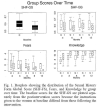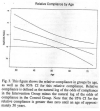Vaginal dilator therapy for women receiving pelvic radiotherapy
- PMID: 20824858
- PMCID: PMC4171967
- DOI: 10.1002/14651858.CD007291.pub2
Vaginal dilator therapy for women receiving pelvic radiotherapy
Update in
-
Vaginal dilator therapy for women receiving pelvic radiotherapy.Cochrane Database Syst Rev. 2014 Sep 8;2014(9):CD007291. doi: 10.1002/14651858.CD007291.pub3. Cochrane Database Syst Rev. 2014. PMID: 25198150 Free PMC article.
Abstract
Background: Many vaginal dilator therapy guidelines advocate routine vaginal dilation during and after pelvic radiotherapy to prevent stenosis (abnormal narrowing of the vagina). The UK Gynaecological Oncology Nurse Forum recommend dilation "three times weekly for an indefinite time period". The UK patient charity Cancer Backup advises using vaginal dilators from two to eight weeks after the end of radiotherapy treatment. Australian guidelines recommend dilation after brachytherapy "as soon as is comfortably possible" and "certainly within four weeks and to continue for three years or indefinitely if possible". However, dilation is intrusive, uses health resources and can be psychologically distressing. It has also caused rare but very serious damage to the rectum.
Objectives: To review the benefits and harms of vaginal dilation therapy associated with pelvic radiotherapy for cancer.
Search strategy: Searches included the Cochrane Central Register of Controlled Trials (CENTRAL) (The Cochrane Library 2008, Issue 4), MEDLINE (1950 to 2008), EMBASE (1980 to 2008) and CINAHL (1982 to 2008).
Selection criteria: Any comparative randomised controlled trials (RCT) or data of any type which compared dilation or penetration of the vagina after pelvic radiotherapy treatment for cancer.
Data collection and analysis: The review authors independently abstracted data and assessed risk of bias. We analysed the mean difference in sexual function scores and the risk ratio for non-compliance at six weeks and three months in single trial analyses. No trials met the inclusion criteria.
Main results: Dilation during or immediately after radiotherapy can, in rare cases, cause damage and there is no persuasive evidence from any study to demonstrate that it prevents stenosis. Data from one RCT showed no improvement in sexual scores in women who were encouraged to practice dilation. Two case series and one comparative study using historical controls suggest that dilation might be associated with a longer vaginal length but these data cannot reasonably be interpreted to show that dilation caused the change in the vagina.
Authors' conclusions: Routine dilation during or soon after cancer treatment may be harmful. There is no reliable evidence to show that routine regular vaginal dilation during or after radiotherapy prevents the late effects of radiotherapy or improves quality of life. Gentle vaginal exploration might separate the vaginal walls before they can stick together and some women may benefit from dilation therapy once inflammation has settled but there are no good comparative supporting data.
Figures



Similar articles
-
Vaginal dilator therapy for women receiving pelvic radiotherapy.Cochrane Database Syst Rev. 2014 Sep 8;2014(9):CD007291. doi: 10.1002/14651858.CD007291.pub3. Cochrane Database Syst Rev. 2014. PMID: 25198150 Free PMC article.
-
Interventions for preventing oral mucositis in patients with cancer receiving treatment: cytokines and growth factors.Cochrane Database Syst Rev. 2017 Nov 28;11(11):CD011990. doi: 10.1002/14651858.CD011990.pub2. Cochrane Database Syst Rev. 2017. PMID: 29181845 Free PMC article.
-
Dilating the vagina to prevent damage from radiotherapy: systematic review of the literature.BJOG. 2010 Apr;117(5):522-31. doi: 10.1111/j.1471-0528.2010.02502.x. Epub 2010 Feb 16. BJOG. 2010. PMID: 20163407
-
Taxane monotherapy regimens for the treatment of recurrent epithelial ovarian cancer.Cochrane Database Syst Rev. 2022 Jul 12;7(7):CD008766. doi: 10.1002/14651858.CD008766.pub3. Cochrane Database Syst Rev. 2022. PMID: 35866378 Free PMC article.
-
Drugs for preventing postoperative nausea and vomiting in adults after general anaesthesia: a network meta-analysis.Cochrane Database Syst Rev. 2020 Oct 19;10(10):CD012859. doi: 10.1002/14651858.CD012859.pub2. Cochrane Database Syst Rev. 2020. PMID: 33075160 Free PMC article.
Cited by
-
Toward clinical care guidelines for supporting rehabilitative vaginal dilator use with women recovering from cervical cancer.Support Care Cancer. 2013 Jul;21(7):1911-7. doi: 10.1007/s00520-013-1726-6. Epub 2013 Feb 17. Support Care Cancer. 2013. PMID: 23417563
-
Results of a Phase I-II Study on Laser Therapy for Vaginal Side Effects after Radiotherapy for Cancer of Uterine Cervix or Endometrium.Cancers (Basel). 2020 Jun 21;12(6):1639. doi: 10.3390/cancers12061639. Cancers (Basel). 2020. PMID: 32575821 Free PMC article.
-
Patients' perception and adherence to vaginal dilator therapy: a systematic review and synthesis employing symbolic interactionism.Patient Prefer Adherence. 2018 Apr 12;12:551-560. doi: 10.2147/PPA.S163273. eCollection 2018. Patient Prefer Adherence. 2018. PMID: 29695897 Free PMC article.
-
Role of vaginal pallor reaction in predicting late vaginal stenosis after high-dose-rate brachytherapy in treatment-naive patients with cervical cancer.J Gynecol Oncol. 2015 Jul;26(3):179-84. doi: 10.3802/jgo.2015.26.3.179. Epub 2015 Apr 29. J Gynecol Oncol. 2015. PMID: 25925294 Free PMC article.
-
Vesicovaginal Fistula and Hydronephrosis Post-radiation for Cervical Cancer: Challenges and Strategies in Management.Cureus. 2024 Jun 26;16(6):e63195. doi: 10.7759/cureus.63195. eCollection 2024 Jun. Cureus. 2024. PMID: 39070346 Free PMC article.
References
References to studies excluded from this review
-
- Bruner DW, Lanciano R, Keegan M, Corn B, Martin E, Hanks GE. Vaginal stenosis and sexual function following intracavitary radiation for the treatment of cervical and endometrial cancer. International Journal of Radiation Oncology, Biology, Physics. 1993;27(4):825–30. - PubMed
-
- Decruze SB, Guthrie D, Magnani R. Prevention of vaginal stenosis in patients following vaginal brachytherapy. Clinical Oncology. 1999;11:46–8. - PubMed
-
- Jeffries SA, Robinson JW, Craighead PS, Keats MR. An effective group psychoeducational intervention for improving compliance with vaginal dilation: a randomized controlled trial. International Journal of Radiation Oncology, Biology, Physics. 2006;65(2):404–11. - PubMed
-
- Poma PA. Postirradiation vaginal occlusion: nonoperative management. International Journal of Gynaecology and Obstetrics. 1980;18(2):90–2. - PubMed
-
- Robinson JW, Faris PD, Scott CB. Psychoeducational group increases vaginal dilation for younger women and reduces sexual fears for women of all ages with gynecological carcinoma treated with radiotherapy. International Journal of Radiation Oncology Biology and Physics. 1999;44(3):497–506. - PubMed
References to ongoing studies
-
- Miles TP, Johnson N. Vaginal elasticity and viscosity after pelvic radiotherapy and implications for practice. International Journal of Gynecological Cancer. 2006;16(S3):712.
-
- Miles TP. A comparison of static and vibrating vaginal dilators to evaluate sexual morbidity in women receiving radiotherapy for carcinoma of the cervix or uterus. (to be submitted in accordance with the requirements for the degree of Doctor of Philosophy) The University of the West of England Bristol, Faculty of Health and Social Care; Bristol, UK: 2010.
Additional references
-
- Abitol MM, Davenport JH. Sexual dysfunction after therapy for cervical carcinoma. American Journal of Obstetrics and Gynaecology. 1974;119:181–9. - PubMed
-
- American Psychiatric Association . Diagnostic and Statistical Manual of Mental Disorders, Sexual and Gender Identity Disorders. Fourth Edition, Text Revision. American Psychiatric Association; Washington DC, USA: 2000. Sexual Aversion Disorder 302.79. http://www.psychiatryonline.com/content.aspx?aID=9929&searchStr=sexual+a....
-
- Owen Mumford Ltd. Brook Hill. Woodstock. Oxford OX20 1TU Amielle Comfort. http://www.owenmumford.com/en/range/21/amielle-comfort.html.
-
- Bertelesen K. Sexual dysfunction after treatment of cervical cancer. Danish Medical Bulletin. 1983;Vol. 30:31–4. - PubMed
-
- GMCT Gynaecological Oncology Guidelines Review Group . Best Clinical Practice Gynaecological Cancer Guidelines [Vaginal stenosis] NSW Department of Health; Sydney: 2009. p. 16. http://www.health.nsw.gov.au/resources/gmct/gynaeonc/pdf/goclinicalguide.... [ISBN 978–1–74187–444–0]
References to other published versions of this review
-
- Johnson N, Miles TP, Cornes P. Dilating the vagina to prevent damage from radiotherapy; systematic review of the literature. British Journal of Obstetrics and Gynaecology. 2010;117(5):522–31. - PubMed
-
-
* Indicates the major publication for the study
-
Publication types
MeSH terms
LinkOut - more resources
Full Text Sources
Medical
Miscellaneous

